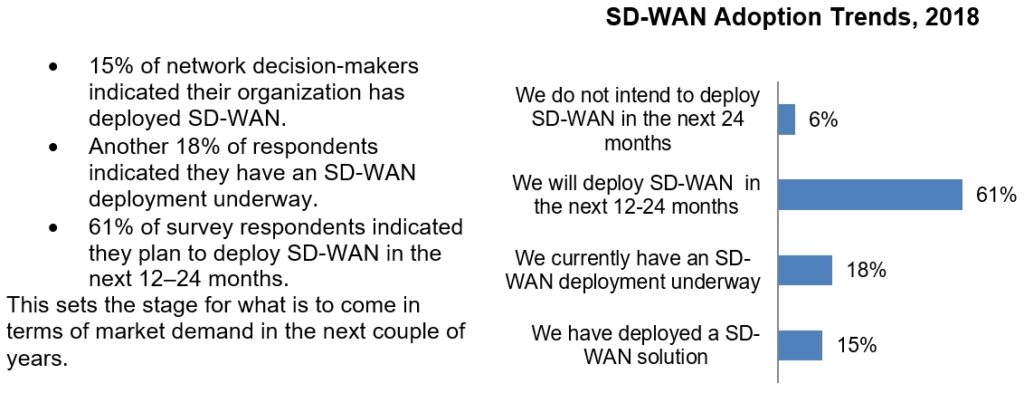
on Posted on Reading Time: 3 minutes
Software-Defined Wide Area Networks (SD-WAN) continue to attract the attention of enterprises eager to leverage the business benefits offered by the technology: for example, faster deployment of branch sites, cost savings from using private and public networks, optimized cloud connectivity, and application-aware routing.
In a recent Frost & Sullivan SD-WAN survey :

Source: 2018 Frost & Sullivan SD-WAN Survey
SD-WAN and Cloud Connectivity
According to the Frost & Sullivan Global Cloud Survey , 75% of global IT decision makers agreed with the statement, “the cloud is the most integral part of our digital transformation strategy.” In the same survey, 37% of the respondents indicated they currently use a hybrid cloud; with another 35% indicating, they plan to use a hybrid cloud in the next 2 years. Additionally, it is common for enterprises to use a multi-cloud deployment for various workloads. Frost & Sullivan Cloud Survey results indicate that 43% of the enterprises use three or more clouds and they expect usage to increase significantly (more than 50%) in the next 2 years.
As enterprise applications get distributed in multiple clouds, the traditional WAN architecture of backhauling traffic to a hub site and then routing to a cloud is inefficient and expensive. SD-WAN enables enterprise IT to predefine business policies through the SD-WAN controller, to specify which cloud applications are suitably accessed directly through the Internet versus backhauled to a hub site. Unlike the traditional static WAN, in an SD-WAN, the ability to software-define policies ensures that connectivity to cloud-based applications is optimized for required quality of service and performance guarantees.
SD-WAN and Network Services
SD-WAN technology is transforming the WAN similar to how Cloud has transformed enterprise data centers. Since you cannot spell SD-WAN without the WAN, there is a huge focus on network services. Our survey results indicate that the most frequent pairing of network services with SD-WAN is dual broadband with Ethernet and Internet links. While there has been a lot of talk about rapid decline of MPLS links due to SD-WAN, our survey results indicated otherwise, with a significant percentage of respondents indicating they will continue to keep MPLS alongside Internet or wireless links. In 2018, Business Ethernet , MPLS VPN and Dedicated Internet Access services combined, represented in excess of $25 billion in revenue.
In the same survey, 50% of the respondents indicated their preference toward buying a fully managed SD-WAN service . In managed SD-WAN, the service provider installs and manages the edge devices, procures and manages access links from multiple network service providers (NSPs), and manages the day-to-day network management aspects of the solution. The preference for fully managed SD-WAN is evident from the partnerships that SD-WAN vendors have established with NSPs, managed service providers (MSPs), value-added resellers (VARs) and system integrators (SIs). Frost & Sullivan forecasts revenues of the to exceed $6 billion by 2020.
SDN, NFV, and SD-WAN
SDN and NFV combined, represent a compelling value proposition for enterprise WAN architectures. The emergence of SD-WAN further enhances the value these two technologies can provide. With the convergence of SDN, NFV and SD-WAN, businesses can use SD-WAN technology to route traffic based on pre-defined policies, change the underlying bandwidth in real-time, and deploy network functions (virtual firewall, virtual WAN optimization, etc.) on demand. While the majority of SD-WAN deployments today are using an SD-WAN appliance, service providers with an advanced SDN and NFV strategy are currently embracing both hardware- and software-based models, to offer SD-WAN as a VNF on a universal CPE.
Conclusion
SD-WAN, SDN, and NFV technologies are affecting the enterprise WAN like never before. Several technologies that are critical to the success of enterprise digital transformation—unified communication and collaboration, cloud computing, advanced network and application security, IoT, and Big Data analytics—have seen limited adoption due to lack of reliable and cost-effective network connectivity. Thanks to SD-WAN, it is now possible for businesses to consider embracing these technologies by using any available bandwidth and optimizing those links to adhere to business policies.
MEF19 will bring together leading SD-WAN vendors, network service providers, and industry research organizations, to highlight the developments in the space. For more details on the conference and sessions, please visit www.mef19.com.
